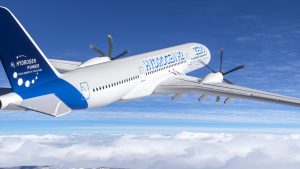CERN and Airbus UpNext have partnered to explore the potential of employing superconducting technologies to develop zero-emission hydrogen planes.
Airbus UpNext – a wholly owned subsidiary of Airbus – has signed a collaboration agreement with CERN to investigate using CERN’s superconducting technologies for particle accelerators in the electrical distribution system of future hydrogen planes. The advanced superconducting technologies could significantly reduce the weight of next-generation aircraft, elevating their efficiency to make net-zero air travel a reality.
Raphaël Bello, CERN’s Director of Finance and Human Resources, commented on the collaboration: “In its research, CERN pushes back the limits of science and engineering and partners with industry to enable innovation, with a positive impact on the environment.
“Our technologies have the potential to be adapted to the needs of future clean transportation and mobility solutions, as this agreement with Airbus demonstrates. This partnership is only a first step in our journey with the European leader in aviation and shows how much we value the excellence of our Member States’ industry.”
The scale of aviation sector emissions
Research from the Air Transport Action Group suggests that in 2019, the aviation industry caused 915 million tonnes of CO2 emissions globally, with humans producing over 43 billion tonnes of CO2 in total. The aviation sector accounted for 2.1% of all human-induced CO2 emissions and was responsible for 12% of CO2 emissions from all sources of transport, whereas road transport equated to 74%.
Despite being significantly lower than other forms of transport, reducing emissions in the aviation industry could contribute significantly to global targets of achieving net-zero transport by 2050. The development of hydrogen-powered planes will be critical to enabling this transition.
How will superconductors advance hydrogen planes?
The newly established partnership will pioneer a demonstrator known as Super-Conductors for Aviation with Low Emissions (SCALE). The project will amalgamate CERN’s superconductor expertise with Airbus UpNext’s industry-leading aircraft design and manufacturing proficiency. If successful, the collaboration could develop a fully integrated, zero-emission hydrogen plane within the next decade.

Sandra Bour-Schaeffer, CEO of Airbus UpNext, said: “Our role at Airbus UpNext is to explore the full potential of technologies for future aircraft and to partner with the world’s leaders to prepare for this future. Partnering with a leading research institute like CERN, which has brought the world some of the most important findings in fundamental physics, will help to push the boundaries of research in clean aerospace as we work to make sustainable aviation a reality.
“We are already developing a superconductivity demonstrator called ASCEND (Advanced Superconducting and Cryogenic Experimental powertraiN Demonstrator) to study the feasibility of this technology for electrically powered and hybrid aircraft. Combining knowledge obtained from our demonstrator and CERN’s unique capabilities in the field of superconductors makes for a natural partnership.”
José Miguel Jimenez, Head of the Technology department at CERN, concluded: “Superconducting technologies have fuelled some of the greatest discoveries in high-energy physics and, if applied to aircraft power distribution systems, would drastically reduce their weight and increase their efficiency. CERN has over 40 years of expertise in building world-record superconducting systems at the core of existing and next-generation particle accelerators. Such systems present negligible resistance to the flow of current, thus transmitting much higher intensities than traditional, heavier, non-superconducting cables.”









